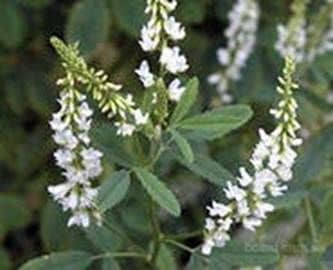
Donnik white is a two-year, rarely one-year-old herbaceous plant of the legume family, with an erect, branched stalk. Sheets are triple: the middle leaf on the cuttings, on the side – almost sessile. Flowers are small, drooping, collected in multicolored axillary brushes, white corolla. The bean is spherical or ovoid, 1-3-seeded.
Wild clover grows on slopes, onions, etc. Cultivate it on an area of close to 5 thousand hectares.
Donnik white is a good honey-flowering period from July to September. At this time it has a very large number of flowers (close to 2 billion / ha). One flower, depending on the natural and climatic conditions, releases 0.030-0.096 mg of sugar in nectar, and honey productivity of 1 ha of sowing is from 120 to 200 kg.
From the crops of sweet clover, commodity honey of light amber color is obtained, with a pleasant smell. It has high taste qualities, contains 37-39% glucose, 40-42% fructose, its diastase number is 13-17 Goth units. The honey crystallizes after 6-8 months. crystallization is fine-grained.
The same meaning is used by the yellow dolnik, which differs from the yellow color of the flowers described and the structure of the beans. Distributed in the same areas and has a similar nectaric productivity.
Как несут пчелы пыльцу. Торт идеалы с медом.
Медоносы